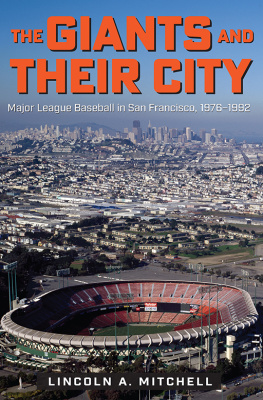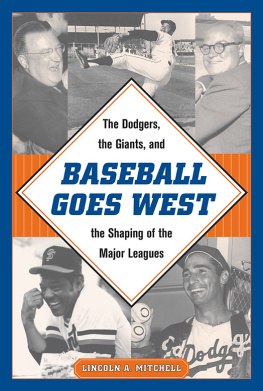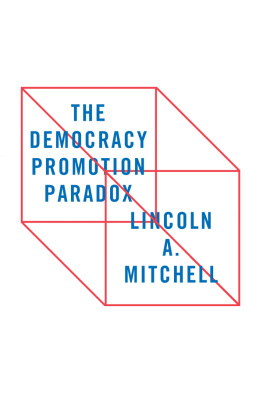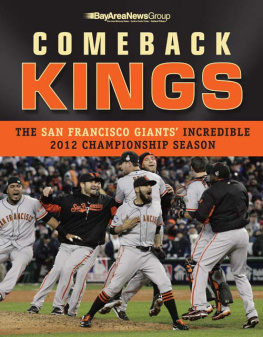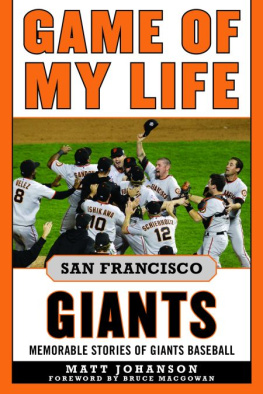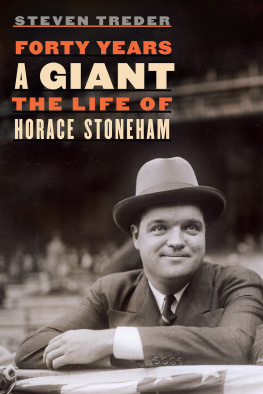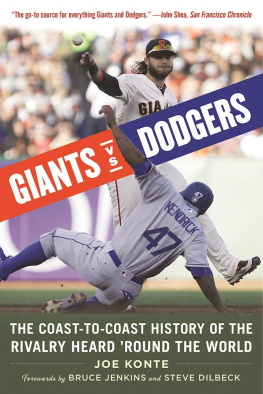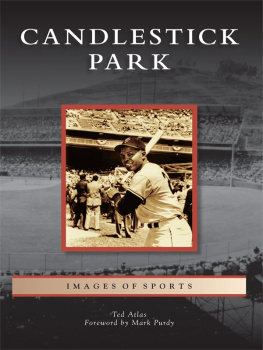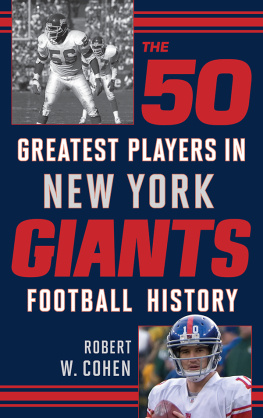
THE GIANTS AND THEIR CITY
The
GIANTS
and
THEIR CITY
Major League Baseball
in San Francisco, 19761992
Lincoln A. Mitchell

2021 by The Kent State University Press, Kent, Ohio 44242
All rights reserved
ISBN 978-1-60635-420-9
Manufactured in the United States of America
No part of this book may be used or reproduced, in any manner whatsoever, without written permission from the Publisher, except in the case of short quotations in critical reviews or articles.
Cataloging information for this title is available at the Library of Congress.
25 24 23 22 21 5 4 3 2 1
CONTENTS
The COVID-19 pandemic made the summer of 2020 a strange time to finish writing a book about baseball in San Francisco. The baseball season did not begin until mid-July, and games were played in ballparks with no fans in attendance. For older Giants fans, the empty ballparks did not feel entirely unprecedented as some of us still remember the mid-1970s. Nonetheless, although we can hope that MLB returns to a full schedule with fans in the stands, as I write this, we do not yet know if that will happen in 2021. Similarly, most of this book was written in 2019, when San Franciscos economy was booming and the city was crowded and congested. The pandemic changed that as well.
The absence of Giants baseball for most of the 2020 season and my own inability to go to San Francisco from my home in New York was not only an unusual context in which to complete a book about the San Francisco Giants but also a disorienting twist to a journey that began in 1976. That was not only the year that Bob Lurie and George Moscone saved the team from going to Toronto, but it was also the year I became a Giants fan. I have remained a fan of the team to this day. Accordingly, this book reflects my perspective as both a scholar of baseball and San Francisco and also as a fan.
Both of these aspects of my writing were enriched by interviews with several former Giants players, including Dusty Baker, Vida Blue, Will Clark, Dave Dravecky, Atlee Hammaker, Mike Krukow, Duane Kuiper, Gary Lavelle, Kevin Mitchell, John Montefusco, Chris Speier, and Robby Thompson. They were all very generous with their time and helped me get a sense of what the team was like when they were playing. Current and former baseball executives, including Larry Baer, Peter Ueberroth, and Bud Selig, were also very valuable interview subjects. Pat Gallagher offered excellent insight into the history of the Croix de Candlestick, the Crazy Crab, and other Giants marketing gambits. Nobody has been with the Giants longer than Mike Murphy. The great stories he told me made this a better book. Bruce Jenkins has observed and written about the Giants for decades. I am grateful for his insights into these years. Three former San Francisco mayors, Art Agnos, Frank Jordan, and Dianne Feinstein, explained how the challenge of keeping the Giants in San Francisco looked from City Hall. Dean Macris, who served as city planner for Mayors Feinstein and Agnos, provided additional information about the efforts to get a downtown ballpark in the 1980s.
Mario Alioto and Suzanna Mitchell from the San Francisco Giants assisted me in contacting some of the former Giants and also in finding the photographs for this book. Pat Johnson, Dennis Desprois, and the George H. W. Bush Library and Museum generously allowed me to use some of their excellent photographs as well. Susan Wadsworth-Booth and her team at the Kent State University Press were great colleagues with whom to work on The Giants and Their City.
Had Bob Lurie not stepped up in 1976 and invested in keeping the team in San Francisco, my life as a baseball fan would have been very different. More than 40 years later, when I approached Bob to discuss the idea of writing this book, he immediately offered to do whatever he could to help me with the project. After that meeting, Bob and Connie Lurie were extremely kind and hospitable and made themselves available for several interviews as well as email exchanges and informal conversations. They also gave me access to their personal Giants archives. Corey Busch encouraged me to write this book, read and gave feedback on early drafts, and helped me set up many of the interviews that contributed to The Giants and Their City. I would not have been able to write this book without his help.
From 1976 to 1992, being a Giants fan was alternately an exhilarating, disappointing, fun, and odd experience. However, I did not have to experience all of that alone. Christian Ettinger, Charles A. Fracchia Jr., Charles Karren, John Maschino, Michael Mason, and my late brother Jonathan Mitchell were my companions while shivering away countless evenings, as well as enjoying more than a few sunny days, at Candlestick Park. In addition to those friends, my family has also helped make this book possible. In the late 1970s, my mother used to drop my brother and I off at the bus stop at Clay and Van Ness so we could catch the Ballpark Express to Candlestick Park. Forty years later she continues to be supportive of, and slightly puzzled by, my passion for baseball. My wife, Marta Sanders, shares both of those sentiments. My two sons, Asher and Reuben, have managed to become Giants fans despite never having lived in San Francisco, although for some reason they are more focused on the team in the twenty-first century. Once again, Isis the dog has been my faithful, patient, and usually silent research assistant.
My father, Alan Sapiro, stopped paying attention to baseball in 1963 when Stan Musial retired, but he read almost everything I wrote for most of the last 20 years. His always encouraging and frequently helpful feedback on my work helped me keep pushing forward with my writing. My father died in September 2019, but part of me still wants to send him my latest column, article, or, in this case, book. I cannot do that anymore, but I can, and do, dedicate this book to him.
On October 29, 2014, with two outs in the bottom of the ninth of Game Seven of the World Series, and the tying run on third, Kansas City Royals catcher Salvador Perez hit a 22 pitch from San Francisco Giants ace Madison Bumgarner into foul territory near third base. Pablo Sandoval, the Giants star third baseman, tapped his thigh with his glove, caught the ball, and then collapsed in happiness onto the field. The Giants had won their third championship in five years.
The Giants have been one of baseballs most successful franchises in the twenty-first century. In addition to their extraordinary five year run from 2010 to 2014, the team plays in a beautiful ballpark nestled next to the San Francisco Bay and sells out almost every gameeven when the team is losing. They are a beloved institution, and a good civic presence in the city that has been their home since 1958.
For baseball fans with a sense of history, this seems kind of natural. The Giants are one of the oldest and most famous franchises in baseball and trace their roots back to the 1880s in New York. While playing in New York in the early part of the twentieth century, when big-league baseball as we know it was taking shape, the Giants emerged as the games marquee franchise, before ceding that claim to the Yankees in the late 1920s.
Many of the games best and most famous players have been Giants. Christy Matty Mathewson, the great pitcher of baseballs early years, was one of the first baseball stars who became a national celebrity. Mattys longtime manager, John McGraw, is still considered a groundbreaking and brilliant baseball man. Willie Mays, the greatest player of the postwar era, spent almost his entire career with the Giants in both New York and San Francisco. Other well-known Giants stars, including Frankie Frisch, Mel Ott, Bill Terry, Willie McCovey, and Juan Marichal, have been among the best and most famous players of their eras. More recently, the slugger Barry Bonds, who was the best player of his generation, spent the last 15 years of his career with the Giants, but has also become, in the eyes of some, the face of the Performance-Enhancing Drug (PED) era in Major League Baseball (MLB).
Next page
